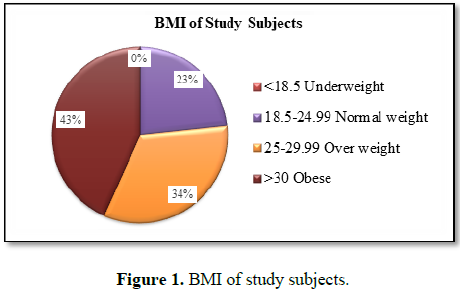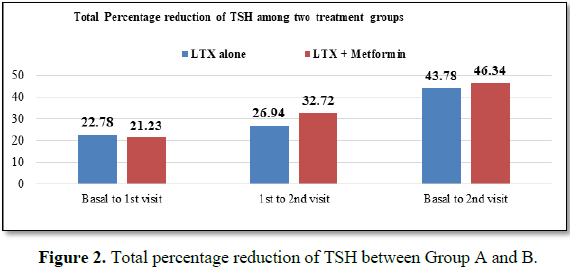860
Views & Citations10
Likes & Shares
Background: The reduction of TSH
levels in SCH patients with metformin alone is unclear and lack of evidence in
clinical practice. Therefore we aimed to observe the efficacy of metformin with
levothyroxine sodium and levothyroxine sodium alone in reduction of TSH levels
in SCH patients.
Aim: To evaluate the
safety and efficacy of Metformin in reduction of TSH Levels in subclinical
hypothyroidism patients.
Methodology: It was a prospective
observational study conducted at Department of Endocrinology, Endolife
Hospital, Guntur, during the period of July 2017 to April 2018 (8 months), the
study was approved from Institutional Human ethics committee. Group A 90
patients were enrolled with SCH and 30 patients are excluded due to lack of
follow-up and they are not meet the inclusion criteria. After exclusion the
study participants are 60. The 60 patients are divided into two groups, group A
(LTX 25 mcg OD alone), group B (LTX 25 mcg+Metformin 500 mg OD). The TSH levels
are measured at baseline and different intervals of baseline to first visit (45
days), first visit to second visit (45 days) and baseline to second visit.
Results: The safety and
efficacy of metformin along with LTX observed by comparing LTX alone in TPO
antibody negative individuals. The TSH levels are measured at baseline, 45 and
90 days after the treatment. Treatment improvement was observed in females as
compare to males in both groups. The percentage deviation between 1st
visits to 2nd visit was found to be 17.37% in males and 21.72%
deviation was observed in females. The percentage deviation between 1st
visits to 2nd visit was found to be 26.71% in males and 24.71%
deviation was observed in females. By observing above data the prominent
percentage reduction of TSH was observed in females than males in both
treatment group A and B and overall the treatment Group B shows more
efficacious than treatment group A.
Conclusion: Our study concludes
that the Metformin suppresses serum TSH levels in individuals with subclinical
hypothyroidism. We observed that a greater reduction of TSH was more in group B
as compared to group A & also we observed that TSH levels were reduced more
in female patients.
Keywords: Levothyroxine sodium,
Metformin, TSH, Safety and efficacy
Abbreviations: BMI: Body Mass Index;
LTX: Levothyroxine Sodium; OD: Once in a Day; PO: Per oss (Oral); SCH:
Subclinical Hypothyroidism; TSH: Thyroid Stimulating Hormone; TPO:
Thyroperoxidase Antibody
Metformin, the most widely
used anti-diabetic drug, is considered as the cornerstone of type 2 diabetes
treatments. Surprisingly, a few years ago it has been reported that serum TSH
level in hypothyroid patients decreased in response to metformin therapy and
increased again when metformin was discontinued [1]. Later this finding has
been confirmed by several studies [2]. The novel effects of metformin on the
thyroid were not confined to hypothyroidism. Due to lack of conclusive data
regarding effect of metformin in patients of mild SCH with TSH level 5-10
mIU/L, the present study
AIM
To evaluate the
safety and efficacy of Metformin in reduction of TSH Levels in subclinical
hypothyroidism patients.
OBJECTIVES
·
To assess the levels of Thyroid Stimulating Hormone (TSH), in Subclinical
hypothyroidism patients.
·
To compare the results of patients who are taking Levothyroxine
(LTX)+Metformin and Levothyroxine (LTX) alone.
·
To monitor adverse drug reactions.
METHODOLOGY
It was a prospective
observational study conducted at Department of Endocrinology, Endoline
Hospital, Guntur, during the period of July 2017 to April 2018 (8 months), the
study was approved from Institutional Human ethics committee. 90 patients were
enrolled with SCH and 30 patients are excluded due to lack of follow-up and
they are not meeting the inclusion criteria. After exclusion the study
participants are 60. The 60 patients are divided into two groups, group A (LTX
25 mcg OD alone) % group B (LTX 25 mcg+Metformin 500 mg OD). The TSH levels are
measured at baseline and different intervals of baseline to first visit (45
days), first visit to second visit (45 days) and baseline to second visit.
Inclusion criteria
• Subclinical hypothyroidism patients of either sex between 25-80
years of age.
• Patients with Thyroid Stimulating Hormone (TSH) between 4.2-10
mIU/L.
• Patients who are on Levothyroxine 25 mcg OD.
• Patients who are on Levothyroxine 25 mcg OD+Metformin 500 mg
OD.
Exclusion criteria
·
Patients who are on
• Estrogen therapy
• Glucocorticoids
• Dopamine
• Bromocriptine
• Iodine
• Lithium and Amiodarone
RESULTS
Table 3 shows that the
percentage reduction of TSH among males and females of treatment Group A (LTX
25 mcg PO, OD) alone. Of 30 patients, 5 males (16.67%) and 25 females (83.33%).
In males, the percentage reduction of TSH was found to be baseline to 1st visit
(21.22%), 1st visit to 2nd visit (23.07%) and baseline to
2nd visit (38.59%), respectively. In females the percentage
reduction was found to be 23.1%, 27.71% and 44.82% with respective intervals.
By observing above data the prominent percentage reduction of TSH was observed
in females than males. The percentage deviation between 1st visits to 2nd
visit was found to be 17.37% in males and 21.72% deviation was observed in
females. By observing above data the prominent % reduction of TSH was observed
in females than males in treatment group A.
Table 4 shows that the
percentage reduction of TSH among males and females of treatment Group B (LTX
25 mcg PO+Metformin 500 mg PO OD). Of 30 patients, 6 males (20%) and 24 females
(80%). In males, the percentage reduction of TSH was found to be baseline to 1st
visit (16.03%), 1st visit to 2nd visit (31.72%) and
baseline to 2nd visit (42.74%), respectively. In females the
percentage reduction was found to be 22.53%, 32.97% and 47.24% with respected
intervals. By observing above data the prominent percentage reduction of TSH
was observed in females than males. The percentage deviation between 1st
visits to 2nd visit was found to be 26.71% in males and 24.71%
deviation was observed in females. By observing above data the prominent
percentage reduction of TSH was observed in females than males in treatment
group B. The overall percentage reduction and efficacy was observed in Group B
as compared to treatment Group B.
Table 5 and Figure 2 shows that, Of 60
patients, 30 Group A (50%) and 30 Group B (50%).the percentage reduction of TSH
was found to be 22.78%, 26.94% and 43.78% between the baseline to 1st
visit, 1st visit to 2nd visit and baseline to 2nd
visit, respectively. In Group B, it was found to be 21.23%, 32.72% and 46.34%
between the baseline to 1st visit, 1st visit to 2nd
visit and baseline to 2nd visit, respectively.
The student T-test was applied for these two groups
and it was found to be, calculated t value shows that there is significant
difference within each group during their baseline to first visit, first to
second visit and baseline to second visit. We are not observed any adverse drug
reactions or drug related problems during our study period.
DISCUSSION
The age range of 25-44 years was found in the study
which was done by Rajput [5], whereas in our study the SCH Patients were lies
between the age of 25-35 years old, off which most of are obese and overweight.
Subclinical hypothyroidism has been detected with increasing frequency in
recent years and is causing major controversies concerning management and
treatment. In the present study patients of subclinical hypothyroidism who are
more obese, and are TPO antibody negative responded favorably to LTX and
Metformin therapy at 24 weeks as compared to individuals of SCH with LTX alone.
Our findings that TSH lowering effect is observed only in individuals who were
TPO antibody negative are in contrast with observation made by Capelli et al.
[6] who showed that significant reduction in TSH level was seen in those
patients on Metformin who had a baseline TSH higher than 2.5 mIU/l independent
of presence or absence of TPO antibodies.
CONCLUSION
Our study concludes that the Metformin suppresses
serum TSH levels in individuals with subclinical hypothyroidism. We observed
that a greater reduction of TSH was more in group B (Levothyroxine+Metformin)
as compared to group A (Levothyroxine alone) after 2nd visit. There
is a significant difference within each group during their baseline to 1st
visit, 1st to 2nd visit and baseline to 2nd visit.
And we also observed that TSH levels were reduced more in female patients.
CONFLICT OF INTEREST
None
ACKNOWLEDGEMENT
We are thankful to department of endocrinology,
Endolife hospital, Guntur for providing facility to execute our research work.
1. Vigersky
RA, Filmore-Nassar A, Glass AR (2006) Thyrotropin suppression by metformin. J
Clin Endocrinol Metab 91: 225-227.
2. Oleandri
SE, Maccario M, Rossetto R, Procopio M, Grottoli SC, et al. (1999) Three month
treatment with metformin or dexfenfluramine does not modify the effects of diet
on anthropometric and endocrine-metabolic parameters in abdominal obesity. J
Endocrinol Invest 22: 134-140.
3. Canaris
G, Manowitz N, Mayor G, Ridgway E (2000) The Colorado thyroid disease
prevalence study. Arch Intern Med 160: 526-534.
4. Pearce
S, Brabant G, Duntas L, Monzani F, Peeters R, et al. (2013) ETA guideline:
Management of subclinical hypothyroidism. Eur Thyroid J 2: 215-228.
5. Rajput
R (2013) Effects of metformin on thyroid function in patients of subclinical
hypothyroidism. J Endocrinol Metab 3: 105-110.
6. Cappelli
C, Rotondi M, Pirola I, Agosti B, Gandossi E, et al. (2009) TSH-lowering effect
of metformin in type 2 diabetic patients: Differences between euthyroid,
untreated hypothyroid and euthyroid on L-T4 therapy patients. Diabetes Care 32:
1589-1590.



